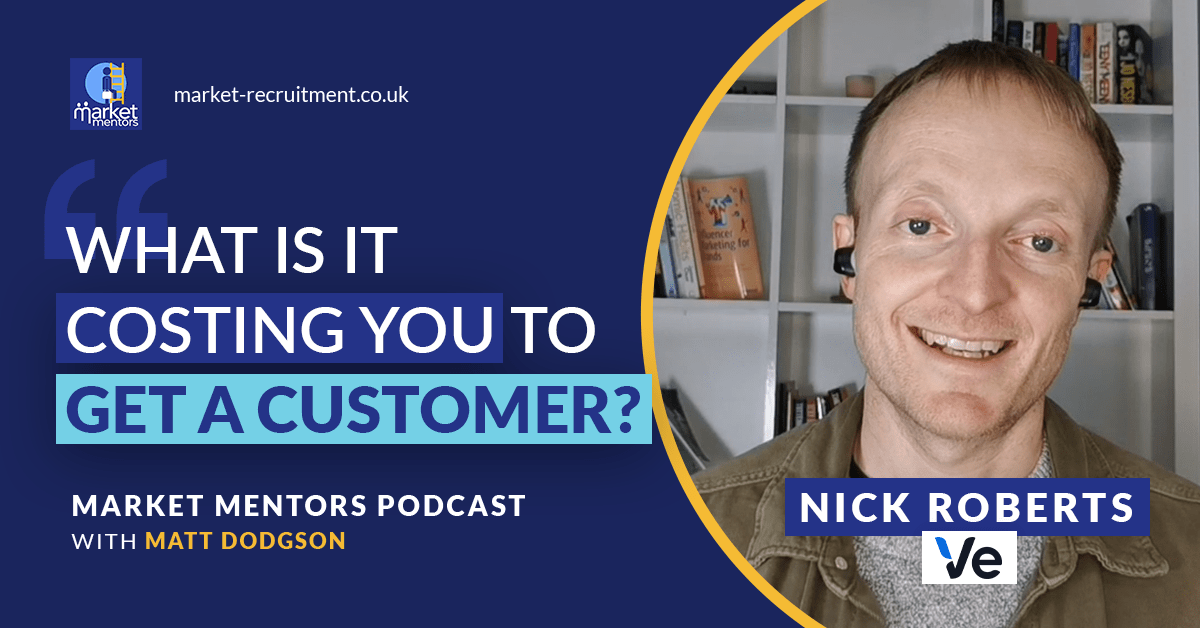
B2B marketers will be all too familiar with the concept of a playbook, often positioned as a silver bullet solution for achieving growth and driving greater results.
But, in order to be effective, this week’s guest believes you have to create your own marketing playbook specific to your business, your product, and your target audience.
In this episode, Nick Roberts talks to Matt Dodgson about how B2B marketers can – and should – develop their own unique playbooks to achieve success.
Who they are: Nick Roberts, Marketing Director at Ve Global.
A bit of background: Nick has been working as a B2B marketing professional for almost a decade, in SaaS companies at various stages of growth.
Nick has been both a candidate and a client for us here at Market Recruitment in the past, so it’s great to catch up with him on this week’s episode.
Where you can find him: You can connect with Nick on LinkedIn here.
Here you’ll find some of the best advice from the podcast that you can easily digest and learn from.
“Having a playbook for demand generation and marketing overall is a really, really smart idea,” said Nick.
“It allows you to have a complete process from A to Z. But I think the problem with using existing playbooks is that you’re essentially trying to replicate what someone else has done. Even if it’s you trying to replicate something else you’ve done in the past yourself.”
“Parts of that playbook might work for you. But unless you’ve got an identical product, an identical audience, and are in an identical time it’s going to be very, very difficult to have that work for you.”
So it’s important to be mindful that no two businesses or products are the same. More importantly, factors like your audience’s opinions and preferences, the technology you and your customers are using, and countless other variables are always changing.
Even if you replicate every step in a previously-successful marketing strategy down to the finest detail, it will never work in the exact same way at two different points in time.
It’s always necessary to track and measure the performance of your messaging. But Nick suggested using a mixture of data analysis and instinct to reach the most effective results.
He explained, “I’m a huge fan of Malcolm Gladwell and his notion of thin-slicing, which is when you’ve got enough information to make a decision that more information isn’t going to improve or worsen that decision making.”
“So, you can absolutely get data to test some of this stuff. I highly recommend implementing things like Google Optimize right away. Start running tests on your messaging on all your pages, or as many pages as you can.”
Nick suggested looking into things like:
Once you do that, you can then start getting some useful data to analyse and base decisions on.
Nick continued, “Most early-stage or even mid-stage start-ups aren’t going to have massive amounts of traffic where you’re getting statistically significant results. But you can get a general feeling after a couple of weeks of the better messaging to go with. Then make that the new message, and then test it again, and then make that the new message, and test it, and test it, and test it. Keep on refining it, but then use your gut feeling to make that key decision.”
“Then flow that out to the rest of your business. I’m a fan of having the SDR team, or your outbound team, or your development team as part of marketing as well. They then have access to the newest messaging as fast as possible, and you can roll those learnings out across your demand generation function very quickly.”
“It’s 100% about where your target customer, your ideal prospect, lives and breathes,” said Nick.
“It’s only that place as often as possible. In the same way that I’m a big advocate of experimenting and testing various messaging, the same thing goes for quick iterative tests in those specific channels.”
Nick turned to an example of when he was working with a company named Global App Testing to demonstrate the importance of this.
He said, “At Global App Testing, one of the targets is very technical folks, and they don’t necessarily enjoy being outbound messaged on LinkedIn, or outbound messaged at all, so we had to find where those people lived online. Even if you know from a previous business, you can create leads via LinkedIn, your new target audience just isn’t living there.”
“So, it’s that playbook thing again, where if you’re just applying the playbook you’ve used before in a past role, you can probably get some leads from that, but it’s not going to generate the massive ground swell that you’re looking for.”
“Run some tests in a couple of sprints,” said Nick. “Have three or four two-week sprints, testing lots of different messaging across lots of different channels, to figure out where you’re getting the earliest traction possible, and then double down. Double down in that channel as much as possible.”
“Have three or four maximum areas that you’re paying attention to, including SEO, if you’re doing that, paid, and then really just double down into those areas and make sure that’s where you live and breathe as much as possible. I think that’s where you’re going to find the best results.”
“That’s how I decide what channels to use,” Nick added. “Until we’ve tapped that well completely dry, then that’s when you move on to another channel.”
Subscribe to our fortnightly newsletter to hear about our latest podcasts, blogs, career advice & jobs.